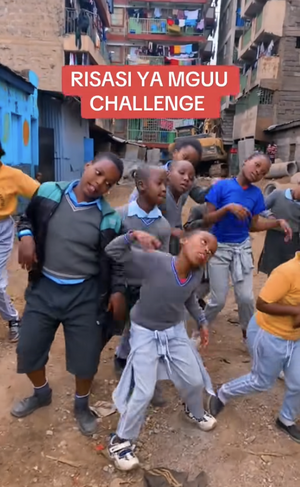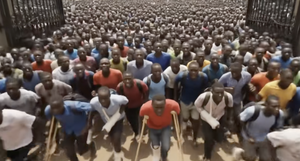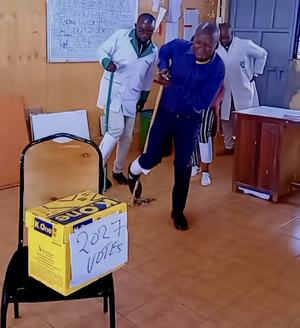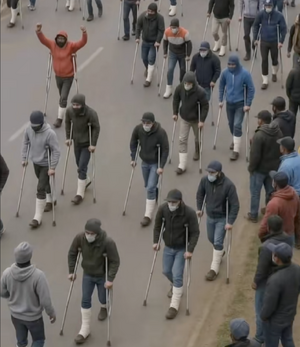Shoot to kill directive 2025
Context, Constitutional Implications and Youth Response
⚠️ More Information Required
This section is incomplete. Please help by adding more verifiable content and references How and Who Can Contribute?
Overview
In June and July 2024, and again in 2025, top Kenyan government officials made inflammatory statements interpreted as incitement to use **lethal force** against peaceful protestors, especially youth-led demonstrators under the Gen Z banner. These remarks, coupled with actual police brutality, sparked national and global outcry and raised serious constitutional concerns.
Leaders and Their Exact Statements
President William Ruto
- Date: July 9, 2025
- Quoted Statement: "Anyone who burns down someone else’s business and property, let them be shot in the leg and go to the hospital as they head to court. Yes, let them not kill, but shoot and break the legs. Destroying people’s property is not right."
Kipchumba Murkomen – Cabinet Secretary for the Interior and National Administration
- Date: June, 2025
- Quoted Statement: “"Askari, fanya kazi yako. Tumia bunduki yako vizuri. Ukiona mtu anaharibu mali ya serikali, risasi moja. Tuko nyuma yenu. Tutaenda kotini pamoja.”
(Translation: "Police officer, do your job. Use your firearm properly. If you see someone destroying government property, one bullet. We are behind you. We will go to court with you.")
Nelson Koech – MP, Belgut
- Date: July, 2025
- Quoted Statement: “I want to thank President William Ruto for saying yesterday, shoot but do not kill. I want to repeat it here. In fact, shoot and kill. You cannot have someone coming after your life, and you do not want to shoot and kill"
Didmus Barasa – MP, Kimilili
- Date: July 2, 2024
- Quoted Statement: “Shoot them. You cannot allow people to burn police stations or destroy our infrastructure.”
- Context: Made during a rally in Bungoma County. He doubled down on earlier government positions, calling for more aggressive policing. https://www.the-star.co.ke/news/2025-06-18-mp-didmus-defends-cops-vows-to-disband-ipoa
What the constitution says
📜 1. - Right to Life – Article 26
“Every person has the right to life.” — Article 26(1) “A person shall not be deprived of life intentionally, except to the extent authorized by this Constitution or other written law.” — Article 26(3)
🕊️ 2. Freedom of Assembly, Demonstration and Petition – Article 37
“Every person has the right, peaceably and unarmed, to assemble, to demonstrate, to picket, and to present petitions to public authorities.” — Article 37
👮 3. Use of Force by Police – Article 244 & National Police Service Act
“The National Police Service shall comply with constitutional standards of human rights and fundamental freedoms.” — Article 244(c) “...Shall strive for the highest standards of professionalism and discipline among its members.” — Article 244(d)
The National Police Service Standing Orders further require that use of force must be:
- Proportionate
- Necessary
- Justifiable
- A last resort
⚖️ 4. Human Dignity & Protection from Torture – Articles 28 and 29
“Every person has inherent dignity and the right to have that dignity respected and protected.” — Article 28 “Every person has the right to freedom and security... which includes the right not to be treated or punished in a cruel, inhuman or degrading manner.” — Article 29(f)
🗳️ 5. Sovereignty of the People – Article 1
“All sovereign power belongs to the people of Kenya and shall be exercised only in accordance with this Constitution.” — Article 1(1)
⚖️ 6. Presumption of Innocence in Kenyan Law - Article 50
In Kenyan law, the right to a fair trial — including the presumption of innocence — is firmly protected under the Kenya 2010 constitution.
Article 50(2)(a) of the Constitution of Kenya, 2010 states:
- "Every accused person has the right to a fair trial, which includes the right—
(a) to be presumed innocent until the contrary is proved;"
This means that:
- An accused person does not have to prove their innocence.
- The burden of proof rests on the prosecution.
- The prosecution must prove the case beyond reasonable doubt.
- Any doubt must be resolved in favour of the accused.
Principles of a Fair Trial in Kenya
- Fair hearing: Conducted before an independent and impartial court.
- Legal representation: The accused has the right to choose and be represented by a legal practitioner.
- Disclosure of evidence: The prosecution is required to disclose all relevant evidence to the defence.
- Timely trial: The trial must be conducted without unreasonable delay.
The Kenyan Constitution strictly prohibits shoot-to-kill directives against unarmed protesters. Peaceful protest is a protected right, and any state response must be lawful, measured, and grounded in respect for human rights.
📜 International law violations
- African Charter on Human and Peoples’ Rights
- Universal Declaration of Human Rights (UDHR)
- UN Human Rights Council Resolution 25/38 – Protection of Human Rights in Protests (2014)
- UN Convention on the Rights of the Child (CRC)
- Convention Against Torture (CAT)
- International Covenant on Civil and Political Rights (ICCPR)
- UN General Assembly Resolution 68/167 – The Right to Privacy in the Digital Age (2013)
- UN Special Rapporteur Reports (especially on extrajudicial, summary or arbitrary executions)
- United Nations Basic Principles on the Use of Force and Firearms by Law Enforcement Officials (1990)
Why It Matters to the young people
- Many young activists were targeted, abducted, or killed despite organizing peaceful demonstrations.
- Such directives aim to crush youth civic expression and dissent.
Legal and Ethical Expectations
- Use of force must be justifiable and proportionate.
- Protesters should be protected under law.
- The Independent Policing Oversight Authority (IPOA) and Judiciary are constitutionally mandated to investigate and prosecute violations.
Reactions and youth response
- Amnesty Kenya: Called the remarks “reckless and unconstitutional.”
- KHRC: Filed legal actions and demanded prosecution of responsible leaders.
- UN Special Rapporteur on Human Rights: Expressed concern over excessive force.
- Youth & Civil Society: Massive backlash on social media and renewed protests across counties.
- A song Risasi Kwa Mguu was introduced *https://www.youtube.com/watch?v=Ah_CUS8Ru44, * https://www.youtube.com/watch?v=IXBwi8Eqg7s




Consequences of Shoot-to-Kill Orders in Kenya (2024–2025)
🩸 Human Cost: Shoot-to-Kill Consequences
📍 Number of People Shot and Killed
According to the Kenya National Commission on Human Rights (KNCHR) and Amnesty International Kenya:
- June 25, 2025 (anniversary of 2024 “Finance Bill” protests):
- At least 75+ people were reported killed, and over **400 injured**, mostly by police live rounds and tear gas.
- July 7, 2025 (Saba Saba Day):
- 31 people killed by police nationwide; hundreds injured and arrested in 17 counties amid crackdowns.
- Across June–July 2025:
- Total fatalities estimated at **≈70** and injuries around **553+**. - Over 532 arrests recorded.
Most victims were young people aged 16–30, including students and peaceful demonstrators.
Note: These are officially confirmed deaths. Civil society groups believe the actual number is higher due to unreported or undocumented killings.
🔫 Number of People Shot and Injured
- Over 500 people were injured, many with gunshot wounds, rubber bullets, or baton injuries.
- Numerous victims were left permanently disabled.
- Some were shot while fleeing or filming protests, indicating excessive and unjustified force.
🔍 Documented Cases
See Remembrance project on Wikizetu, documenting lives lost, state brutality, and youth resistance in the push for justice and democracy in Kenya.
🕊️ Abductions and Enforced Disappearances
- Over 50 Gen Z protesters were abducted by plain-clothed officers.
- Some returned with signs of torture, others remain missing.
- Human rights groups have labeled this as state-sponsored repression.
⚖️ Accountability Status
📜 Impact on Society
- Growing public distrust in the government and security forces.
Sources
- Standard Media, July 1, 2024
- Daily Nation, June 25, 2024
- Kipchumba Murkomen Official Twitter, July 1, 2024
- Amnesty Kenya, June–July 2024 Press Releases
- Kenya Human Rights Commission
- Gen Z Kenya Official Twitter
- Constitution of Kenya (2010)
More Sources
- https://www.amnestykenya.org/ 2024 Annual Report – «Still Here» – Amnesty International Kenya] – reports 63 protest-related deaths, 83 abductions, and over 2,000 arrests during the Gen Z protests in 2024
- https://www.knchr.org/Articles/ArtMID/2432/ArticleID/1207/STATE-OF-HUMAN-RIGHTS-IN-KENYA-JULY-2023-NOVEMBER-2024 2023–2024 State of Human Rights in Kenya Report] – documents 1,376 arbitrary arrests, 610 injuries, and 74 enforced disappearances during protests between June–November 2024
- https://www.bbc.com/news/world-africa-65787619 BBC: Young Lives Lost in Kenya’s Finance Bill Protests, July 2024] – coverage of youth casualties, including 12‑year‑old victims
- https://www.standardmedia.co.ke/national/article/2001522539/report-exposes-systemic-police-abuses-in-2024-youth-protests The Standard: Report exposes systemic police abuses in 2024 youth protests] – quoted data: 63 deaths, 63 abductions, 26 missing persons, over 600 injuries
- https://www.hrw.org/news/2024/06/28/kenya-witnesses-describe-police-killing-protesters HRW: Witnesses Describe Police Killing Protesters, June 2024] – investigation into killings during Finance Bill protests, citing at least 30 deaths and extrajudicial shootings
- https://www.hrw.org/news/2025/06/26/kenya-hold-authorities-accountable-for-protesters-deaths HRW: Hold Authorities Accountable for Protesters’ Deaths, June 2025] – reporting on 2025 protests, with at least 16 deaths and over 400 injuries from live fire
- https://www.bbc.com/news/articles/c9dgv5e6447o 'Shoot in the leg' - Kenyan leader orders police to curb violent protests
- https://www.reuters.com/world/africa/kenyas-president-orders-police-shoot-violent-protesters-leg-2025-07-09/ Kenya's * president orders police to shoot violent protesters in the leg
- https://www.theguardian.com/world/2025/jul/09/shoot-them-in-the-leg-kenyan-presidents-anti-protest-rhetoric-hardens-as-death-toll-rises‘Shoot them in the leg’: Kenyan president’s anti-protest rhetoric hardens as death toll rises
- https://www.aljazeera.com/video/newsfeed/2025/7/9/shoot-their-legs-kenyas-president-ruto-rails-against-looters#flips-6375460482112:0, https://www.aljazeera.com/video/newsfeed/2025/7/9/shoot-their-legs-kenyas-president-ruto-rails-against-looters ‘Shoot their legs’: Kenya’s President Ruto rails against looters
- https://www.africanews.com/2025/07/09/shoot-in-the-leg-ruto-orders-kenyan-police-to-curb-protest-vandalism// "Shoot in the leg": Ruto orders Kenyan police to curb protest vandalism
- https://eastleighvoice.co.ke/saba%20saba%20day%202025-saba%20saba%20day%20demonstrations-saba%20saba%20day%20protests-saba%20saba%20demonstrations-saba%20saba%20protests/177069/belgut-mp-nelson-koech-urges-police-to-shoot-to-kill-violent-protesters Belgut MP says shoot in the leg order not enough, urges use of 'maximum' force against rioters
- https://www.citizen.digital/news/shoot-and-kill-mp-nelson-koech-defends-police-on-killing-violent-protestors-n366079 Belgut MP says shoot in the leg order not enough, urges use of 'maximum' force against rioters * https://www.standardmedia.co.ke/article/2001523931/shoot-and-kill-belgut-mp-urges-lethal-force-against-rioters Belgut MP says shoot in the leg order not enough, urges use of 'maximum' force against rioters